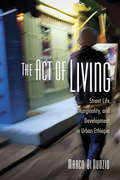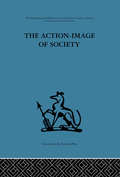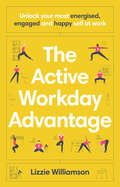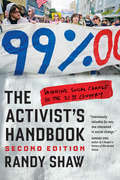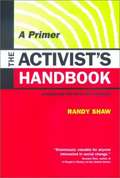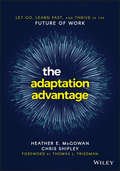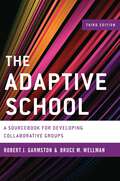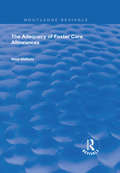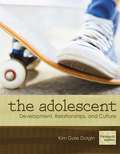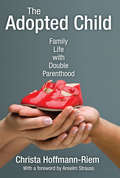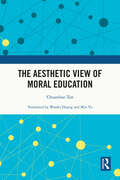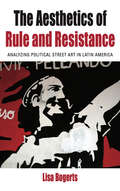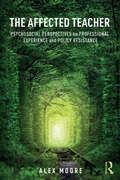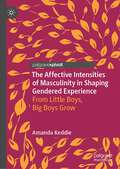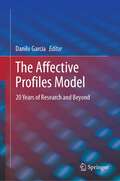- Table View
- List View
The Acquisition of Heritage Languages
by Montrul SilvinaHeritage speakers are native speakers of a minority language they learn at home, but due to socio-political pressure from the majority language spoken in their community, their heritage language does not fully develop. In the last decade, the acquisition of heritage languages has become a central focus of study within linguistics and applied linguistics. This work centres on the grammatical development of the heritage language and the language learning trajectory of heritage speakers, synthesizing recent experimental research. The Acquisition of Heritage Languages offers a global perspective, with a wealth of examples from heritage languages around the world. Written in an accessible style, this authoritative and up-to-date text is essential reading for professionals, students, and researchers of all levels working in the fields of sociolinguistics, psycholinguistics, education, language policies and language teaching.
The Act of Living: Street Life, Marginality, and Development in Urban Ethiopia
by Marco Di NunzioThe Act of Living explores the relation between development and marginality in Ethiopia, one of the fastest growing economies in Africa. Replete with richly depicted characters and multi-layered narratives on history, everyday life and visions of the future, Marco Di Nunzio's ethnography of hustling and street life is an investigation of what is to live, hope and act in the face of the failing promises of development and change. Di Nunzio follows the life trajectories of two men, "Haile" and "Ibrahim," as they grow up in the Ethiopian capital Addis Ababa, enter street life to get by, and turn to the city's expanding economies of work and entrepreneurship to search for a better life. Apparently favourable circumstances of development have not helped them achieve social improvement. As their condition of marginality endures, the two men embark in restless attempts to transform living into a site for hope and possibility.By narrating Haile and Ibrahim's lives, The Act of Living explores how and why development continues to fail the poor, how marginality is understood and acted upon in a time of promise, and why poor people's claims for open-endedness can lead to better and more just alternative futures. Tying together anthropology, African studies, political science, and urban studies, Di Nunzio takes readers on a bold exploration of the meaning of existence, hope, marginality, and street life.
The Action-Image of Society on Cultural Politicization
by Alfred WillenerTavistock Press was established as a co-operative venture between the Tavistock Institute and Routledge & Kegan Paul (RKP) in the 1950s to produce a series of major contributions across the social sciences. This volume is part of a 2001 reissue of a selection of those important works which have since gone out of print, or are difficult to locate. Published by Routledge, 112 volumes in total are being brought together under the name The International Behavioural and Social Sciences Library: Classics from the Tavistock Press. Reproduced here in facsimile, this volume was originally published in 1970 and is available individually. The collection is also available in a number of themed mini-sets of between 5 and 13 volumes, or as a complete collection.
The Active Workday Advantage: Unlock your most energised, engaged and happy self at work
by Lizzie WilliamsonMove more and find a happier, healthier, more productive you. After a long day of sitting at work, your body aches, you have no energy, you' re drained of creativity and your mood has hit rock bottom. But that' s just part of your job, right? Wrong! It doesn' t have to be that way. The Active Workday Advantage will educate and inspire you to incorporate micro moves – small and powerful moments of movement – into your daily routine. Follow the suggestions in this fun and motivating book and you' ll boost your energy levels, improve your strength and flexibility, keep your attention span switched on, spark your creativity and reboot your brain for peak performance.With easy-to-follow, research-based suggestions for low-effort ways to move more and feel better, workplace wellness expert Lizzie Williamson empowers you to change your perspective on exercise, prioritise active habits and take control of your physical and mental wellbeing at work.
The Activist's Handbook
by Randy ShawIn this thoroughly revised and updated edition of The Activist's Handbook, Randy Shaw's hard-hitting guide to winning social change, the author brings the strategic and tactical guidance of the prior edition into the age of Obama. Shaw details how activists can best use the Internet and social media, and analyzes the strategic strengths and weaknesses of rising 21st century movements for immigrant rights, marriage equality, and against climate change. Shaw also highlights increased student activism towards fostering greater social justice in the 21st century. The Activist's Handbook: Winning Social Change in the 21st Century details the impact of specific strategies on campaigns across the country, from Occupy Wall Street to battles over sweatshops, the environment, AIDS policies, education reform, homelessness, and more: How should activists use new media tools to expose issues and mobilize grassroots support? When should activists form coalitions, and with whom? How are students--be they DREAMers seeking immigration reform or college activists battling ever-increasing tuition costs--winning major campaigns? Whether it's by inspiring "fear and loathing" in politicians, building diverse coalitions, using ballot initiatives, or harnessing the media, the courts, and the electoral process towards social change, Shaw--a longtime activist for urban issues--shows that with a plan, positive change can be achieved. In showing how people can win social change struggles against even overwhelming odds, The Activist's Handbook is an indispensable guide not only for activists, but for anyone interested in the future of progressive politics in America.
The Activist's Handbook: A Primer (Updated edition)
by Randy ShawStrategies on how to win grass roots campaigns by developing proactive agendas and making sound decisions, with many examples of successful campaigns. As campaigns increasingly require building coalitions among diverse, multi-issue constituencies, the skill of ensuring good process both internally and externally is even more vital.
The Adaptation Advantage: Let Go, Learn Fast, and Thrive in the Future of Work
by Heather E. McGowan Chris ShipleyA guide for individuals and organizations navigating the complex and ambiguous Future of Work Foreword by New York Times columnist and best-selling author Thomas L. Friedman Technology is changing work as we know it. Cultural norms are undergoing tectonic shifts. A global pandemic proves that we are inextricably connected whether we choose to be or not. So much change, so quickly, is disorienting. It's undermining our sense of identity and challenging our ability to adapt. But where so many see these changes as threatening, Heather McGowan and Chris Shipley see the opportunity to open the flood gates of human potential—if we can change the way we think about work and leadership. They have dedicated the last 5 years to understanding how technical, business, and cultural shifts affecting the workplace have brought us to this crossroads, The result is a powerful and practical guide to the future of work for leaders and employees. The future can be better, but only if we let go of our attachment to our traditional (and disappearing) ideas about careers, and what a "good job" looks like. Blending wisdom from interviews with hundreds of executives, The Adaptation Advantage explains the profound changes happening in the world of work and posits the solution: new ways to think about careers that detach our sense of pride and personal identity from our job title, and connect it to our sense of purpose. Activating purpose, the authors suggest, will inherently motivate learning, engagement, empowerment, and lead to new forms of pride and identity throughout the workforce. Only when we let go of our rigid career identities can we embrace and appreciate the joys of learning and adapting to new realities—and help our organizations do the same. Of course, making this transition is hard. It requires leaders who can attract and motivate cognitively diverse teams fueled by a strong sense of purpose in an environment of psychological safety—despite fierce competition and external pressures. Adapting to the future of work has always called for strong leadership. Now, as a pandemic disrupts so many aspects of work, adapting is a leadership imperative. The Adaptation Advantage is an essential guide to help leaders meet that challenge.
The Adaptive School: A Sourcebook For Developing Collaborative Groups (Christopher-gordon New Editions Ser.)
by Robert J. Garmston Bruce M. WellmanThis 3rd edition of the award winning Adaptive Schools Sourcebook provides both a theoretical and practical guide for groups and teams to develop and focus their collaborative energies to improve teaching practices and enhance student-learning outcomes. In five sections: Becoming Adaptive, Collaboration Matters, Meetings are Teachers’ Work, Resources for Inquiry, and Conflict, Change and Community, the authors draw on decades of personal experiences in schools and research from multiple disciplines to present powerful tools and useful templates for structuring the work of productive professional communities in schools. Readers will learn ways to develop and sustain the fundamental elements for enhancing social capital in schools: distinguishing between dialogue and discussion, establishing seven norms of collaboration, automating language patterns for inquiry and problem solving, facilitating groups and data teams, engaging in productive conflict, and building community. The book offers links to video clips demonstrating key skills, inventories for assessing groups, instruments for assessing personal skills, and a collection of over 150 meeting strategies and facilitator moves for engaging group members in productive interactions.
The Adequacy of Foster Care Allowances (Routledge Revivals)
by Nina OldfieldFirst published in 1997, this timely examination of allowances paid to foster carers demonstrates clear evidence that the nature of foster care is changing. The degree of difficulty in caring for the average child is greater than ever before making the tasks asked of carers more demanding and skilful. The fostering allowances were subject to five tests of adequacy. Evidence showed that allowances have maintained their value over time and were adequate to meet the normal costs of child rearing but not the extra or indirect costs of fostering. Moreover, a unique cross national study of payments uncovered that Britain has lower levels of allowance than more than half the 15 countries examined. This book contributes to the debate on the measurement of living standards. It uses budget standard methodology to estimate the cost of a child living a modest but adequate lifestyle in the 1990s.
The Adolescent: Development, Relationships, and Culture (13th edition)
by Kim Gale DolginThe book is as comprehensive as possible within the confines of one text. The adolescent is discussed within the context of contemporary society. Material includes both theory and life experiences of adolescents and discusses physical, intellectual, emotional, psychosexual, social, familial, educational, and vocational aspects of adolescent development and behavior. It also reviews psychosocial problems of adolescents.
The Adopted Child: Family Life with Double Parenthood (Marriage And Family Studies Ser.)
by Christa Hoffmann-RiemThis exploration of the experiences of adopting parents and children offers unusual insight into adoption's complexity and its profound impact on family life. Based on the author's research in Germany, where she lived and taught, The Adopted Child has a great deal to say about child rearing and identity, as well as offering insights into similarities and differences in family life and adoption in Germany and the United States.Hoffmann-Reim takes the reader through the decision to adopt, the adoption placement procedure, and the transition from "applicant" to "mother and father." She explores differences between emotions experienced in adopting a baby, a toddler, and an older child, and how these emotions can affect relations with the world outside the nuclear family. A central concern is secrecy and disclosure with regard to the adopted child's origins.Based on case studies and extensive interviews, The Adopted Child has fascinated American readers as it did those in Germany. Professionals as well as those interested in adoption and family life in general will find it significant. Sociologists will find it solidly grounded in concepts and traditions from a diversity of related disciplines. And anyone interested in Germans and German society will find the materials revealing, and the author's interpretation insightful and wise.
The Adult Safeguarding Practice Handbook 2e
by Kate SpreadburyThe second edition of this best-selling book provides an essential guide to best practice in adult safeguarding. It has been updated to include recent legislative, guidance and research-based developments and relates them to useful practice examples. Featuring new support materials and key case studies, it includes: • a focus on working with marginalised groups under the safeguarding and prevention duties, including ‘transitional’ safeguarding; • an exploration of best practice in light of changes to national guidance and research; • findings from a range of Safeguarding Adults Reviews with reflections on the outcomes of two national (England) Safeguarding Review Audits; and • an expansion of the concepts of professional curiosity and trauma-informed/-aware approaches. Students and practitioners are guided to reflect on practice and to extend their skills, knowledge and values to become confident and competent in the complex area of adult safeguarding.
The Aesthetic View of Moral Education
by Chuanbao TanThe Aesthetic View of Moral Education is the result of in-depth interdisciplinary research in education and aesthetic studies. This book advocates the use of aesthetic ideas and methods to transform moral education activities, which are often trapped in a state of forced indoctrination. This book aims to address the problems of moral education in China and share certain commonalities in the exploration of educational theory. The aesthetic view of moral education is a new and practical philosophy of education. The author's theory of moral education as the appreciation of beauty, the creation of beauty, and the theory of the attainment of the ultimate realm of moral education provide an in-depth analysis of the functions of aesthetic education for moral cultivation. The author also offers unique interpretations of the aesthetic transformation of the process of moral education itself and the pursuit of the realm of moral life and education. This book will be essential reading for students and scholars of education and philosophy, East Asian studies, and readers interested in China's cultural traditions.
The Aesthetics of Rule and Resistance: Analyzing Political Street Art in Latin America (Protest, Culture & Society #29)
by Lisa BogertsEffective visual communication has become an essential strategy for grassroots political activists, who use images to publicly express resistance and make their claims visible in the struggle for political power. However, this “aesthetics of resistance” is also employed by political and economic elites for their own purposes, making it increasingly difficult to distinguish from the “aesthetics of rule.” Through illuminating case studies of street art in Buenos Aires, Bogotá, Caracas, and Mexico City, The Aesthetics of Rule and Resistance explores the visual strategies of persuasion and meaning-making employed by both rulers and resisters to foster self-legitimization, identification, and mobilization.
The Aesthetics of Rule and Resistance: Analyzing Political Street Art in Latin America (Protest, Culture & Society #29)
by Lisa BogertsEffective visual communication has become an essential strategy for grassroots political activists, who use images to publicly express resistance and make their claims visible in the struggle for political power. However, this “aesthetics of resistance” is also employed by political and economic elites for their own purposes, making it increasingly difficult to distinguish from the “aesthetics of rule.” Through illuminating case studies of street art in Buenos Aires, Bogotá, Caracas, and Mexico City, The Aesthetics of Rule and Resistance explores the visual strategies of persuasion and meaning-making employed by both rulers and resisters to foster self-legitimization, identification, and mobilization.
The Aesthetics, Poetics, and Rhetoric of Soccer (Routledge Research in Sport, Culture and Society)
by Ridvan Askin Catherine Diederich Aline BieriSoccer has long been known as 'the beautiful game'. This multi-disciplinary volume explores soccer, soccer culture, and the representation of soccer in art, film, and literature, using the critical tools of aesthetics, poetics, and rhetoric. Including international contributions from scholars of philosophy, literary and cultural studies, linguistics, art history, and the creative arts, this book begins by investigating the relationship between beauty and soccer and asks what criteria should be used to judge the sport’s aesthetic value. Covering topics as diverse as humor, national identity, style, celebrity, and social media, its chapters examine the nature of fandom, the role of language, and the significance of soccer in contemporary popular culture. It also discusses what one might call the ‘stylistics’ of soccer, analyzing how players, fans, and commentators communicate on and off the pitch, in the press, on social media, and in wider public discourse. The Aesthetics, Poetics, and Rhetoric of Soccer makes for fascinating reading for anybody with an interest in sport, culture, literature, philosophy, linguistics, and society.
The Affect Theory Reader 2: Worldings, Tensions, Futures (ANIMA: Critical Race Studies Otherwise)
by Gregory J. Seigworth and Carolyn PedwellBuilding on the foundational Affect Theory Reader, this new volume gathers together contemporary scholarship that highlights and interrogates the contemporary state of affect inquiry. Unsettling what might be too readily taken-for-granted assumptions in affect theory, The Affect Theory Reader 2 extends and challenges how contemporary theories of affect intersect with a wide range of topics and fields that include Black studies, queer and trans theory, Indigenous cosmologies, feminist cultural analysis, psychoanalysis, and media ecologies. It foregrounds vital touchpoints for contemporary studies of affect, from the visceral elements of climate emergency and the sensorial sinews of networked media to the minor feelings entangled with listening, looking, thinking, writing, and teaching otherwise. Tracing affect’s resonances with today’s most critical debates, The Affect Theory Reader 2 will reorient and disorient readers to the past, present, and future potentials of affect theory.Contributors. Lauren Berlant, Lisa Blackman, Rizvana Bradley, Ann Cvetkovich, Ezekiel J. Dixon-Román, Adam J. Frank, M. Gail Hamner, Omar Kasmani, Cecilia Macón, Hil Malatino, Erin Manning, Derek P. McCormack, Patrick Nickleson, Susanna Paasonen, Tyrone S. Palmer, Carolyn Pedwell, Jasbir K. Puar, Jason Read, Michael Richardson, Dylan Robinson, Tony D. Sampson, Kyla Schuller, Gregory J. Seigworth, Nathan Snaza, Kathleen Stewart, Elizabeth A. Wilson
The Affected Teacher: Psychosocial Perspectives on Professional Experience and Policy Resistance
by Alex MooreAt a time when teaching and learning policy too often presents itself in a simplistic input-output language of measurable targets and objectives, The Affected Teacher explores the role played by emotionality in how professional life is experienced by school teachers. The book argues that, in the very highly organised and structured social spaces of public institutions, emotionality - or, more precisely, all that is included in the concept of ‘affect’ - needs to be recognised and validated, rather than ignored or pathologised. It explores how neoliberal education policy seeks to mould professional subjectivities, relationships and practices; how teachers experience and ‘manage’ their feelings; and the role that affect plays in guiding either compliance with or resistance to often unpopular policy directives. Drawing on a rich body of original data comprising formal and informal discussions with a range of teachers, the case is argued for psychoanalytically and politically informed individual and group reflexivity, both as a form of professional and personal development and as a way of keeping alive alternative beliefs and understandings regarding the purposes of education. The Affected Teacher is relevant to practising schoolteachers and to undergraduate and graduate students and academics involved in education related courses such as policy studies, education management and the sociology of education, as well as disciplines related to psychosocial studies and psychoanalysis.
The Affective Dynamics of Mass Protests: Midān Moments and Political Transformation in Egypt and Turkey (Routledge Studies in Affective Societies)
by Cilja Harders Bilgin AyataThis book examines the connection between affects, mobilisation, and political transformation. Offering unique insights into the affective and emotional dynamics of occupied Tahrir and Taksim Squares, this book builds a novel understanding of urban mass protests and their capacity to “travel” across time and space. Its Midān Moment concept breaks new ground in affect and emotion studies with a focus on political transformation in Egypt and Turkey. It is based on empirically grounded research which covers the 2011 and 2013 uprisings and their authoritarian aftermath. This book will appeal to scholars and students interested in affect and emotion studies in a range of disciplinary areas, including political science, sociology, anthropology, area studies, cultural studies, gender studies, and postcolonial studies.
The Affective Intensities of Masculinity in Shaping Gendered Experience: From Little Boys, Big Boys Grow
by Amanda KeddieThis book tells a story of masculinity through the experiences of one boy, ‘Adam’. From four different studies and time periods, it tracks moments of significance in his life over a period of 20 years. These moments highlight the ways in which Adam is both drawn towards and away from a hegemonic masculinity of physical toughness, domination, competition and an opposition to ‘the feminine’. The book is set against the backdrop of a long history of contentious gender politics in Australia and globally but particularly responds to the renewed attention to the social construction of masculinities in the current #MeToo climate. Against this backdrop, nuanced and longitudinal accounts of boys’ and men’s experiences of masculinity are significant because they can offer insight into the complex bodily, social, economic, and historical forces that configure masculinities. Such understandings are important in our endeavours as those who educate, support and work with boys and men to transform gender inequalities.
The Affective Profiles Model: 20 Years of Research and Beyond
by Danilo GarciaThis timely volume provides an up-to-date exploration of the affective profiles model, a person-centered means of understanding the affective system. It presents the etiology underpinning the affective system and compares the model with other existing personality models, such as the Big Five Model, and the Cloninger’s Biopsychosocial Model. Most important, it examines the affective profiles model in relation to well-being, which includes life satisfaction, as well as psycho-logical health. As such, it illuminates the problems of depression, anxiety, and sleep disorders. Based on a wealth of longitudinal, cross-cultural and intervention studies, this book offers a critical view of the affective profiles model that will enrich both further research and clinical practice.
The Affects of Pedagogy in Literary Studies (Routledge Interdisciplinary Perspectives on Literature)
by Christopher Lloyd Hilary EmmettThe Affects of Pedagogy in Literary Studies considers the ways in which teachers and students are affected by our encounters with literature and other cultural texts in the higher education classroom. The essays consider the range of emotions and affects elicited by teaching settings and practices: those moments when we in the university are caught off-guard and made uncomfortable, or experience joy, anger, boredom, and surprise. Featuring writing by teachers at different stages in their career, institutions, and national or cultural settings, the book is an innovative and necessary addition to both the study of affect, theories of learning and teaching, and the fields of literary and cultural studies.
The Affirmative Action Empire: Nations and Nationalism in the Soviet Union, 1923-1939
by Terry MartinThe Soviet Union was the first of Europe's multiethnic states to confront the rising tide of nationalism by systematically promoting the national consciousness of its ethnic minorities and establishing for them many of the institutional forms characteristic of the modern nation-state. In the 1920s, the Bolshevik government, seeking to defuse nationalist sentiment, created tens of thousands of national territories. It trained new national leaders, established national languages, and financed the production of national-language cultural products.This was a massive and fascinating historical experiment in governing a multiethnic state. Terry Martin provides a comprehensive survey and interpretation, based on newly available archival sources, of the Soviet management of the nationalities question. He traces the conflicts and tensions created by the geographic definition of national territories, the establishment of dozens of official national languages, and the world's first mass "affirmative action" programs.Martin examines the contradictions inherent in the Soviet nationality policy, which sought simultaneously to foster the growth of national consciousness among its minority populations while dictating the exact content of their cultures; to sponsor national liberation movements in neighboring countries, while eliminating all foreign influence on the Soviet Union's many diaspora nationalities. Martin explores the political logic of Stalin's policies as he responded to a perceived threat to Soviet unity in the 1930s by re-establishing the Russians as the state's leading nationality and deporting numerous "enemy nations."
The Affordable Housing Reader
by J. Rosie Tighe Elizabeth J. MuellerThe Affordable Housing Reader brings together classic works and contemporary writing on the themes and debates that have animated the field of affordable housing policy as well as the challenges in achieving the goals of policy on the ground. The Reader – aimed at professors, students, and researchers – provides an overview of the literature on housing policy and planning that is both comprehensive and interdisciplinary. It is particularly suited for graduate and undergraduate courses on housing policy offered to students of public policy and city planning. The Reader is structured around the key debates in affordable housing, ranging from the conflicting motivations for housing policy, through analysis of the causes of and solutions to housing problems, to concerns about gentrification and housing and race. Each debate is contextualized in an introductory essay by the editors, and illustrated with a range of texts and articles. Elizabeth Mueller and Rosie Tighe have brought together for the first time into a single volume the best and most influential writings on housing and its importance for planners and policy-makers.
The Affordable Housing Reader
by J. Rosie Tighe Elizabeth J. MuellerThis second edition of The Affordable Housing Reader provides context for current discussions surrounding housing policy, emphasizing the values and assumptions underlying debates over strategies for ameliorating housing problems experienced by low-income residents and communities of color. The authors highlighted in this updated volume address themes central to housing as an area of social policy and to understanding its particular meaning in the United States. These include the long history of racial exclusion and the role that public policy has played in racializing access to decent housing and well-serviced neighborhoods; the tension between the economic and social goals of housing policy; and the role that housing plays in various aspects of the lives of low- and moderate-income residents. Scholarship and the COVID-19 pandemic are raising awareness of the link between access to adequate housing and other rights and opportunities. This timely reader focuses attention on the results of past efforts and on the urgency of reframing the conversation. It is both an exciting time to teach students about the evolution of United States’ housing policy and a challenging time to discuss what policymakers or practitioners can do to effect positive change. This reader is aimed at students, professors, researchers, and professionals of housing policy, public policy, and city planning.

